Michigan is home to a variety of falcons, known for their incredible speed and hunting skills. These birds of prey are often seen soaring high in the sky or perched on tall trees and cliffs. Falcons have sharp eyesight, allowing them to spot prey from a distance, and their powerful talons make them skilled hunters. In Michigan, you can find several types of falcons, each with unique features and behaviors. Whether you’re a birdwatcher or just curious about wildlife, learning about these fascinating birds can be a rewarding experience.
5 Types of Falcons in Michigan
| # | Falcon Name | Description |
|---|---|---|
| 1 | Peregrine Falcon | A medium-sized falcon with a blue-gray back and barred underparts. Known for its incredible speed and hunts birds and small mammals. |
| 2 | American Kestrel | The smallest falcon in Michigan with a reddish back, blue wings, and white face. It feeds on insects and small rodents in open fields. |
| 3 | Merlin | A small falcon with dark blue-gray plumage and a streaked chest. Prefers forests and hunts birds and insects. |
| 4 | Gyrfalcon | The largest falcon with white, gray, or dark plumage. Found in open tundra and coasts, hunting birds and small mammals. |
| 5 | Prairie Falcon | A medium-sized falcon with a brown back, pale underparts, and dark spots. Lives in deserts and grasslands, preying on birds and small mammals. |
Falcons in Michigan: A Comprehensive Guide
Falcons are fascinating birds of prey known for their incredible speed, sharp vision, and hunting skills. In Michigan, several types of falcons can be seen throughout the year. This guide provides detailed information about the falcons found in Michigan, including their appearances, habits, and the best ways to spot them.
1. Peregrine Falcon
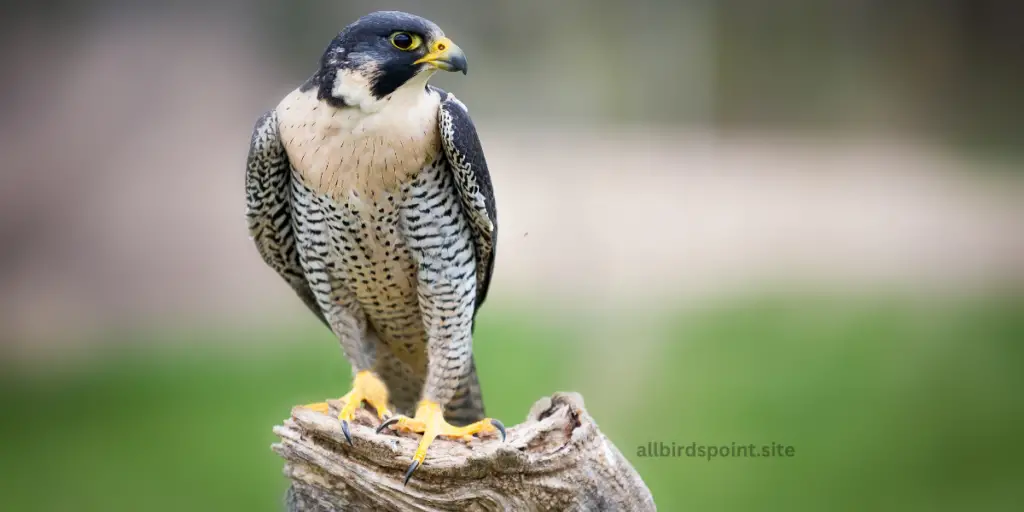
Overview
The Peregrine Falcon is one of the most well-known falcons due to its amazing speed. It is the fastest bird in the world, capable of diving at speeds over 240 miles per hour. This speed is used during its hunting dive, called a stoop. Peregrine Falcons have sleek bodies and sharp talons, which help them catch other birds in mid-air.
Appearance
Peregrine Falcons are medium-sized raptors. They have a blue-gray back, a white belly with black bars, and a black crown on their heads. They also have a dark line running from their beak to their eyes, which gives them a distinctive “moustache” look. These features help them blend into their surroundings while hunting.
Habitat
In Michigan, Peregrine Falcons are often found in urban areas, nesting on tall buildings and bridges. They also like natural cliffs and ledges, especially along the Great Lakes. Their ability to adapt to city environments has helped them recover from past declines.
Diet
Peregrine Falcons mainly eat other birds. Their diet includes pigeons, doves, and smaller songbirds. They use their speed and sharp talons to catch their prey mid-flight, making them expert hunters.
Conservation Status
The Peregrine Falcon faced significant threats in the past due to pesticide use, particularly DDT, which caused their numbers to drop dramatically. However, conservation efforts, such as banning harmful chemicals and protecting nesting sites, have helped the Peregrine Falcon population recover. They are now more common and stable.
Table: Peregrine Falcon
| Characteristic | Description |
|---|---|
| Lifespan | 13-17 years (in the wild) |
| Size | Medium (15-20 inches in length, 3.5-foot wingspan) |
| Appearance | Blue-gray back, white and black barred underside, black crown, dark “moustache” mark on face |
| Diet | Primarily birds, such as pigeons, doves, and other small to medium-sized birds |
| Location | Urban areas (tall buildings), cliffs near Great Lakes |
| Behavior | Solitary hunters, incredibly fast, uses high-speed dives to catch prey |
| Breeding | 3-4 eggs per clutch, both parents help incubate and care for chicks |
2. American Kestrel
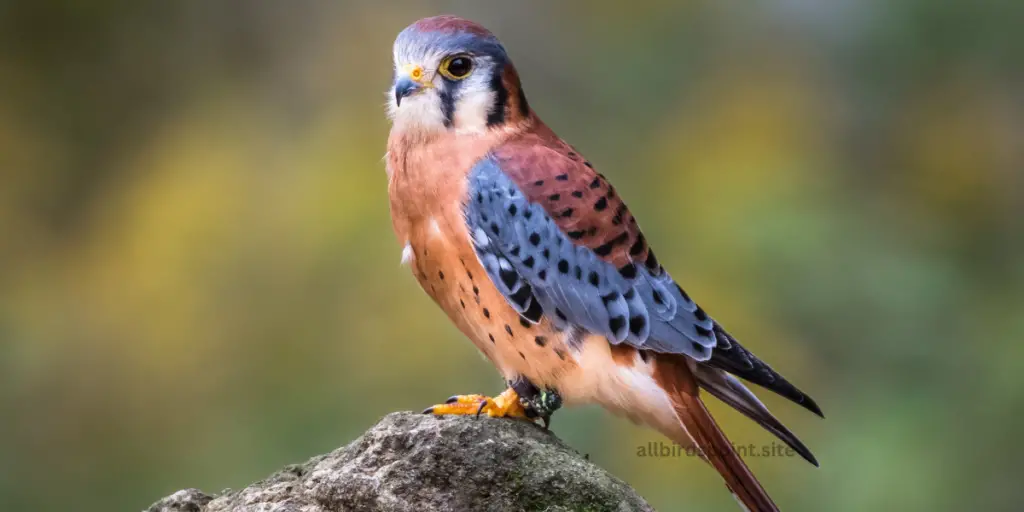
Overview
The American Kestrel is the smallest falcon in North America. Despite its small size, it is a skilled hunter known for its bright colors and distinctive hovering flight. This small raptor is often seen perched on power lines or fence posts, where it scans the ground for prey.
Appearance
Males have colorful plumage with a reddish-brown back, blue-gray wings, and a white face with black spots. Females are less colorful, with more uniform brown feathers. Both genders have a distinctive pattern that makes them easy to identify.
Habitat
American Kestrels are adaptable and can live in various habitats, including open fields, farmlands, and suburban areas. In Michigan, they are commonly seen in grassy fields and along roadsides. They are also frequent visitors to backyard bird feeders, where they hunt for insects and small mammals.
Diet
The diet of the American Kestrel primarily consists of insects, such as grasshoppers and beetles. They also eat small mammals like voles and mice, and occasionally small birds. The kestrel is known for its hunting method called “kiting,” where it hovers in the air to look for prey.
Conservation Status
The American Kestrel is not currently endangered, but it faces threats from habitat loss and changes in agricultural practices. Conservation efforts include preserving open spaces and providing nesting boxes to support their population.
Table: American Kestrel
| Characteristic | Description |
|---|---|
| Lifespan | 5-10 years (in the wild) |
| Size | Small (9-12 inches in length, 2-foot wingspan) |
| Appearance | Males: Reddish-brown back, blue-gray wings, white face with black spots; Females: Brownish tones |
| Diet | Insects, small mammals, occasionally small birds |
| Location | Open fields, farmlands, suburban areas |
| Behavior | Territorial, hovers while hunting to spot and catch prey |
| Breeding | 4-5 eggs per clutch, both parents involved in feeding and raising chicks |
3. Merlin
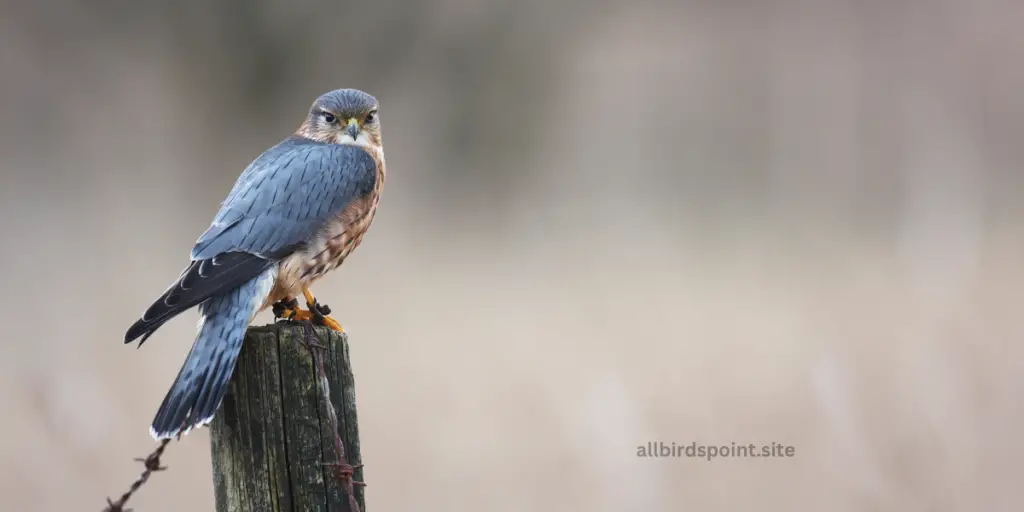
Overview
The Merlin is a small, fast-flying falcon known for its aggressive hunting style. It is smaller than the Peregrine Falcon but is a fierce predator that preys on small birds and insects.
Appearance
Merlins have a dark blue-gray back and a streaked chest. Males are generally darker than females, who have more brownish tones. Their compact size and sharp beak make them efficient hunters.
Habitat
Merlins prefer forested and open woodland areas but can also be found in more urban settings. In Michigan, they are commonly seen in wooded areas and occasionally in suburban neighborhoods. They are known for their territorial behavior, especially during the breeding season.
Diet
Merlins primarily hunt small birds, such as sparrows and warblers. They also eat insects and other small prey. Their hunting technique involves fast, direct flights and aggressive chases to catch their targets.
Conservation Status
The Merlin has a stable population and is not currently listed as endangered. However, like other raptors, it faces potential threats from habitat loss and environmental changes. Conservation efforts focus on preserving natural habitats and ensuring a healthy environment for these birds.
Table: Merlin
| Characteristic | Description |
|---|---|
| Lifespan | 5-10 years (in the wild) |
| Size | Small (9-12 inches in length, 2-foot wingspan) |
| Appearance | Dark blue-gray back, streaked chest; males are darker, females have more brownish tones |
| Diet | Small birds, insects |
| Location | Forests, open woodlands, sometimes suburban areas |
| Behavior | Aggressive, territorial, uses fast, direct flight to hunt |
| Breeding | 4-6 eggs per clutch, both parents help raise the chicks |
4. Gyrfalcon
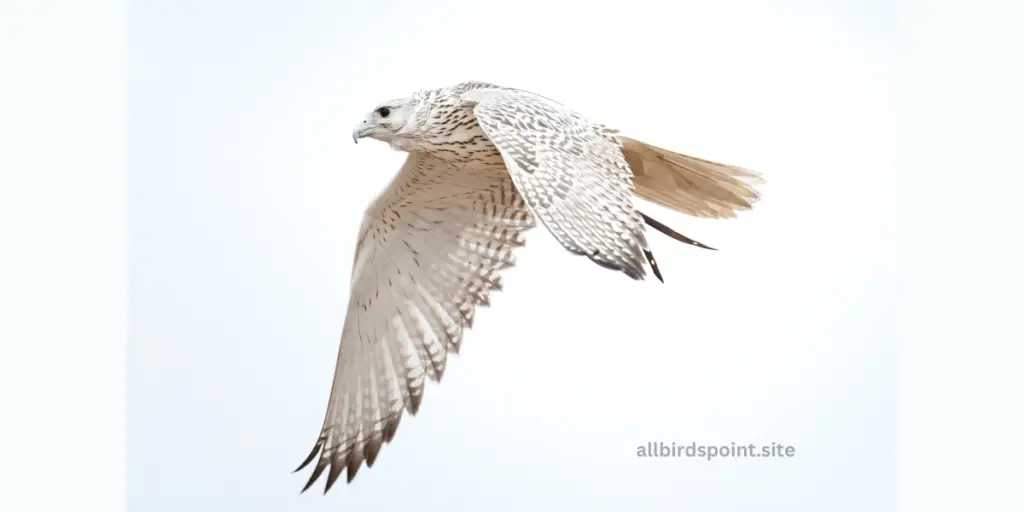
Overview
The Gyrfalcon is the largest species of falcon and is known for its impressive size and strength. It is adapted to cold environments and is a powerful predator capable of hunting large prey.
Appearance
Gyrfalcons have a broad wingspan and can have plumage ranging from white to dark gray. White Gyrfalcons are particularly striking and can be easily recognized. Their size and coloration vary depending on their age and geographic location.
Habitat
Gyrfalcons are native to Arctic regions but can sometimes be spotted in Michigan during the winter months. They are typically found in open landscapes such as tundra and boreal forests. In Michigan, they are seen in open fields and near large bodies of water.
Diet
The diet of the Gyrfalcon includes large birds, such as ducks, and small mammals, like rabbits. Its powerful talons and strong beak allow it to catch and kill larger prey compared to other falcon species.
Conservation Status
The Gyrfalcon is not currently endangered but faces threats from habitat changes and environmental shifts in its Arctic range. In Michigan, sightings are rare, and they are primarily winter visitors. Conservation efforts are focused on protecting their Arctic habitats and monitoring their populations.
Table: Gyrfalcon
| Characteristic | Description |
|---|---|
| Lifespan | 15-20 years (in the wild) |
| Size | Large (20-25 inches in length, nearly 4-foot wingspan) |
| Appearance | Plumage ranges from white to dark gray; white Gyrfalcons are particularly striking |
| Diet | Large birds (like ducks), small mammals (like rabbits) |
| Location | Arctic regions; in Michigan, seen in open fields and near lakes |
| Behavior | Solitary, strong and powerful, hunts large prey |
| Breeding | 3-5 eggs per clutch, both parents care for the chicks |
5. Prairie Falcon
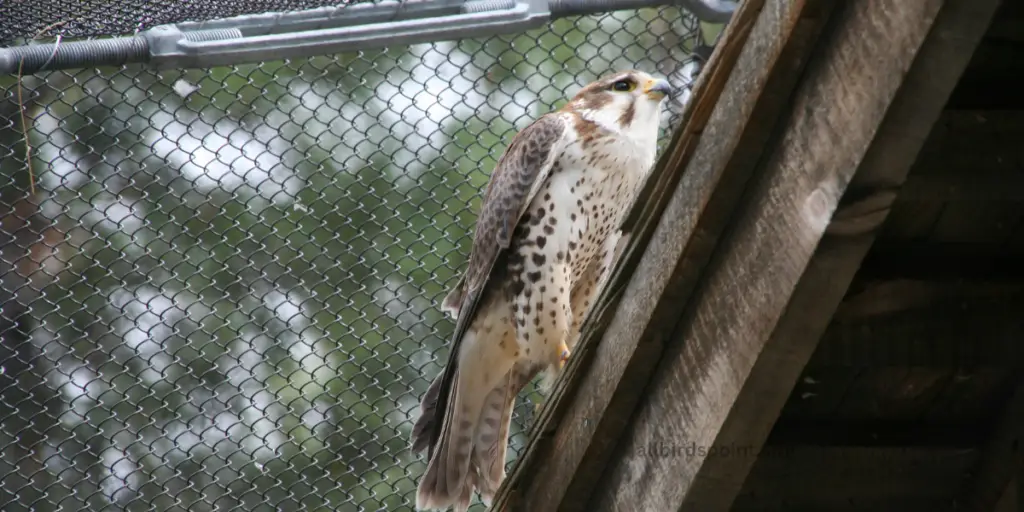
Overview
The Prairie Falcon is a medium-sized falcon known for its adaptability to open landscapes. It has a light brown back and a pale, streaked chest. This falcon is skilled at hunting in wide-open spaces.
Appearance
The Prairie Falcon has a light brown back with a pale chest that is streaked with dark lines. It also has a dark “mustache” mark and eye line that are
characteristic of this species. Its appearance allows it to blend into its open habitat.
Habitat
Although more commonly found in the western United States, the Prairie Falcon occasionally migrates to Michigan. It prefers open fields, grasslands, and areas with few trees. During migration, they can be spotted in these types of habitats across Michigan.
Diet
The Prairie Falcon primarily eats small mammals, such as ground squirrels and rabbits. It also preys on birds and insects. Its hunting method involves flying low over the ground to spot and capture prey.
Conservation Status
The Prairie Falcon is not considered endangered and has a stable population. However, changes in land use and habitat destruction can impact their numbers. Conservation efforts focus on preserving open spaces and monitoring their populations.
Table: Prairie Falcon
| Characteristic | Description |
|---|---|
| Lifespan | 8-12 years (in the wild) |
| Size | Medium (15-18 inches in length, 3.5-foot wingspan) |
| Appearance | Light brown back and wings, pale streaked chest, dark “mustache” and eye line |
| Diet | Small mammals (like ground squirrels), birds, insects |
| Location | Open fields, grasslands; in Michigan during migration |
| Behavior | Solitary, flies low to surprise prey |
| Breeding | 3-5 eggs per clutch, female incubates, male provides food |
Conclusion
Falcons are an important part of Michigan’s birdlife, each species playing a unique role in the ecosystem. From the speedy Peregrine Falcon to the large and powerful Gyrfalcon, these birds of prey are remarkable in their hunting abilities and adaptability. Understanding their habits and conserving their habitats helps ensure that these majestic birds continue to thrive in Michigan.
Whether you’re a birdwatcher hoping to catch a glimpse of these falcons or just curious about the wildlife in your area, knowing more about them enriches your appreciation of Michigan’s natural beauty.
FAQs
Q: What types of falcons are found in Michigan?
A: Michigan is home to five notable falcon species: Peregrine Falcon, American Kestrel, Merlin, Gyrfalcon, and Prairie Falcon.
Q: How can I identify a Peregrine Falcon?
A: The Peregrine Falcon has a blue-gray back, white underside with black bars, and a distinctive dark line from its beak to its eyes.
Q: What is the smallest falcon in Michigan?
A: The smallest falcon in Michigan is the American Kestrel. It has bright plumage and a small size compared to other falcons.
Q: Where do Gyrfalcons typically live?
A: Gyrfalcons are native to Arctic and sub-Arctic regions but can occasionally be spotted in Michigan during winter months.
Q: What do Merlins eat?
A: Merlins primarily hunt small birds like sparrows and warblers, but they also eat insects.
Q: Are falcons in Michigan protected?
A: Yes, several falcon species in Michigan are protected by conservation laws, and efforts are in place to preserve their habitats.
Q: When is the best time to see a Prairie Falcon in Michigan?
A: Prairie Falcons are most commonly seen in Michigan during migration periods in the fall and spring.

1 thought on “Falcons of Michigan: 5 Key Species with Photos”